
A handheld game console, or simply handheld console, is a small, portable self-contained video game console with a built-in screen, game controls and speakers. Handheld game consoles are smaller than home video game consoles and contain the console, screen, speakers, and controls in one unit, allowing players to carry them and play them at any time or place.
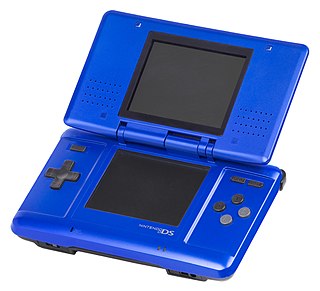
The Nintendo DS is a foldable handheld game console produced by Nintendo, released globally across 2004 and 2005. The DS, an initialism for "Developers' System" or "Dual Screen", introduced distinctive new features to handheld games: two LCD screens working in tandem, a built-in microphone and support for wireless connectivity. Both screens are encompassed within a clamshell design similar to the Game Boy Advance SP. The Nintendo DS also features the ability for multiple DS consoles to directly interact with each other over Wi-Fi within a short range without the need to connect to an existing wireless network. Alternatively, they could interact online using the now-defunct Nintendo Wi-Fi Connection service. Its main competitor was Sony's PlayStation Portable during the seventh generation of video game consoles.

The Visual Memory Unit (VMU), also referred to as the Visual Memory System (VMS) in Japan and Europe, is the primary memory card produced by Sega for the Dreamcast home video game console. The device features a monochrome liquid crystal display (LCD), multiplayer gaming capability, second screen functionality, a real-time clock, file manager, built-in flash memory, and sound capability. Prior to the launch of the Dreamcast, a special Godzilla edition VMU, preloaded with a virtual pet game, was released on July 30, 1998, in Japan.

The Pokémon Mini is a handheld game console that was designed and manufactured by Nintendo and themed around the Pokémon media franchise. It is the smallest game system with interchangeable cartridges ever produced by Nintendo, weighing just under two and a half ounces. It was first released in North America on November 16, 2001, and was only available for purchase at the Pokémon Center and via its website. This was followed by releases in Japan on December 14, 2001, and in Europe on March 15, 2002. The system was released in three colors: Wooper Blue, Chikorita Green, and Smoochum Purple.
Homebrew, when applied to video games, refers to software produced by hobbyists for proprietary video game consoles which are not intended to be user-programmable. The official documentation is often only available to licensed developers, and these systems may use storage formats that make distribution difficult, such as ROM cartridges or encrypted CD-ROMs. Many consoles have hardware restrictions to prevent unauthorized development.
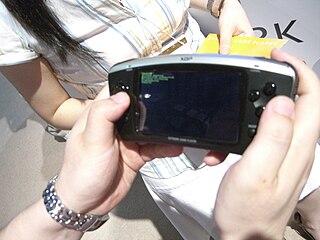
The XGP was a concept portable video game system created by the Korean company GamePark as the follow-up to its GP32 handheld. Initially announced in 2005, the XGP was finally announced in March 2006 along with the release of the similar XGP Mini and the XGP Kids. The company went bankrupt before releasing any of the models.
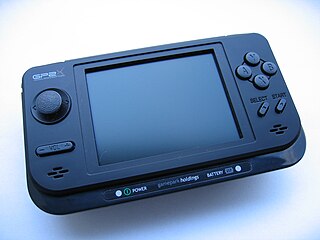
The GP2X is a Linux-based handheld video game console and portable media player developed by South Korean company GamePark Holdings. It was released on November 10, 2005, in South Korea only.

Elgato is a brand of consumer technology products. The brand was manufactured and designed by Elgato Systems, founded in 2010 by Markus Fest and was headquartered in Munich, Germany, until 2018 when the brand was sold to Corsair.

The Game Boy is an 8-bit fourth generation handheld game console developed and manufactured by Nintendo. It was first released in Japan on April 21, 1989, in North America later the same year, and in Europe in late 1990. It was designed by the same team that developed the Game & Watch series of handheld electronic games and several Nintendo Entertainment System (NES) games: Satoru Okada, Gunpei Yokoi, and Nintendo Research & Development 1.

Magical Tetris Challenge is a puzzle game by Capcom for the Nintendo 64, Game Boy Color, and PlayStation. It is a version of Tetris featuring Disney characters. It is one of the few Nintendo 64 games to be entirely in 2D, in addition to being Capcom's first game for the console.

A ROM cartridge, usually referred to in context simply as a cartridge, cart, or card, is a replaceable part designed to be connected to a consumer electronics device such as a home computer, video game console or, to a lesser extent, electronic musical instruments.

The Dingoo is a handheld gaming console that supports music and video playback and open game development. The system features an on-board radio and recording program. It was sold to consumers in three colors: white, black, and pink. It was released in February 2009 and had sold over 1 million units.
The Turbo File devices from ASCII Corporation are external storage devices for saved game data on various Nintendo consoles. They have been sold only in Japan, and are mainly supported by ASCII's own games. The first one was designed primarily to allow players transfer data between the Wizardry games released on the Famicom.
Kevin "Kevtris" Horton is an American electrical engineer known for his work with Analogue with the Analogue Nt Mini, Super Nt, and the Mega Sg.
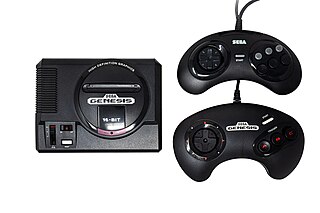
The Sega Genesis Mini, known as the Mega Drive Mini in regions outside of North America, is a dedicated console modeled on the Sega Genesis. The Mini emulates the original console's 16-bit hardware, and includes 42 games made available through emulation software by M2. It was released in North America and Japan in September 2019 and in Europe and the Middle East in October 2019. A follow-up, Sega Genesis Mini 2, was released in October 2022 and includes 60 games from the Genesis and Sega CD.
The Floppotron is a musical instrument created by Polish engineer Paweł Zadrożniak.

The Evercade is a handheld game console developed and manufactured by UK company Blaze Entertainment. It focuses on retrogaming with ROM cartridges that each contain a number of emulated games. Development began in 2018, and the console was released in May 2020, after a few delays. Upon its launch, the console offered 10 game cartridges with a combined total of 122 games.
The Anbernic RG351 is a Linux-based handheld game console created in China by Anbernic. The console uses a microSD card for storage and is a digital ROM-only console. It is the successor to the RG350, and has emerged as a prominent handheld console for retrogaming alongside the Retroid Pocket 2, with the screen aspect ratio of some models particularly optimized for Game Boy Advance titles. It is sold in several models with different shells and screen resolutions, but similar internal specifications. Critics have praised its quality and functionality, but criticized certain aspects of its design.
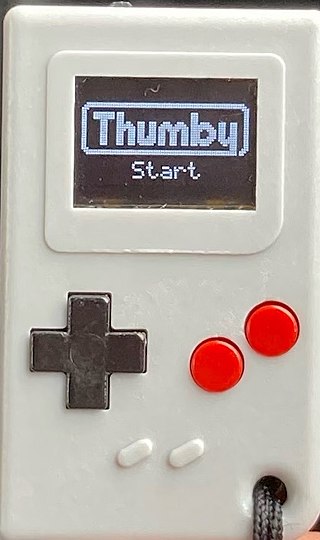
The Thumby is a small keychain-sized programmable game console produced by TinyCircuits of Akron, Ohio and funded by a Kickstarter campaign. The console measures 1.2 by 0.7 by 0.3 inches.















